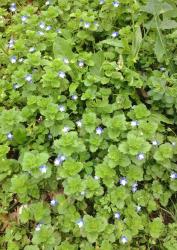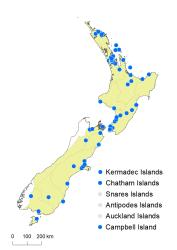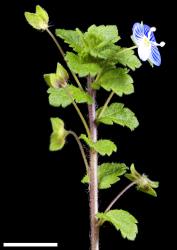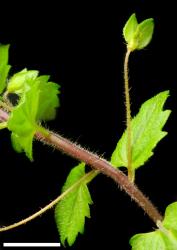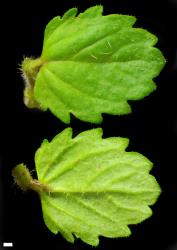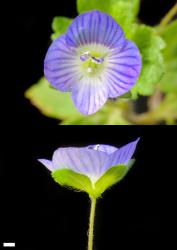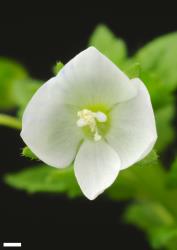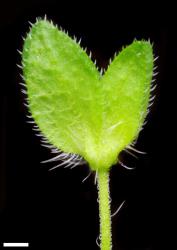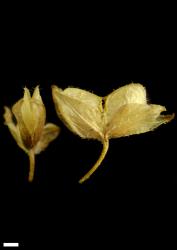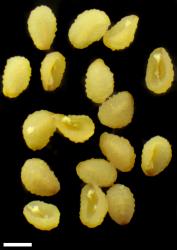- Taxon
- Gallery
- ≡ Veronica tournefortii C.C.Gmel., Fl. Bad. 1, 39 (1805) nom. illeg., non Veronica tournefortii Vill.
- = Veronica buxbaumii Ten., Fl. Napol. 1, 7, t. 1 (1811) nom. illeg., non Veronica buxbaumii F.W.Schmidt 1791
- = Veronica areolata Colenso, Trans. & Proc. New Zealand Inst. 24: 392 (1892)
Annual herb to 0.1 m tall. Stems prostrate to decumbent and rooting at nodes, eglandular-pubescent; hairs uniform. Leaf bud indistinct; leaves separating while very small, opposite-decussate, erecto-patent to spreading; lamina thin, ovate to broad ovate, sometimes deltoid, 6–35 mm long, 5–30 mm wide, dull green above, paler beneath, midrib and palmate secondary veins evident; surfaces eglandular-hairy; margin pubescent, serrate; teeth in 3–8 pairs; apex rounded to sub-acute; base truncate; petiole 0.5–7.0 mm long. Inflorescence a terminal raceme, 200–500 mm long; flowers distant, 12–50, all bisexual; bracts alternate, leaf-like; pedicels spreading, 5–15 mm long, up to 40 mm long and incurved at fruiting, with short, antrorse, eglandular hairs and scattered longer eglandular or occasionally glandular hairs. Calyx lobes 4, tapered to narrow obtuse apex, sub-equal, 5–7 mm long, with short, antrorse hairs on margins and a few longer ones on calyx tube. Corolla 8–12 mm diameter; tube white and yellow, c. 1 mm long, much < calyx, eglandular-hairy inside; lobes 4, usually sky-blue, rarely white, erecto-patent to spreading, unequal, orbicular to broadly elliptical, 5–8 mm long, rounded; nectar guides dark blue or purple, rarely absent. Stamen filaments white or pale blue, 2–3 mm long; anthers dark blue. Style glabrous, 1.5–3.0 mm long. Capsules angustiseptate, didymous with prominent veins, diverging obtuse lobes and broad sinus between, eglandular- and glandular-hairy in distal half, 3.5–4.0 mm long, 6–7 mm at widest point. Seeds ellipsoid, smooth and concave on funicle side, wrinkled and convex on back, straw-yellow to brown, 1.5–1.8 mm long.
Veronica persica is distinctive among the common weedy speedwells in New Zealand. Plants can be identified by their coarsely toothed leaves, lax terminal inflorescences of alternate leaf-like bracts and pedicellate blue flowers, and distinctive capsules, which are broader than long, with widely spreading lobes, shallow sinus, and ciliate margins. The anterior corolla lobe is usually, but not always, paler than the other three lobes, and the short stamens are curved and more or less erect alongside the style.
Plants of V. persica have been misidentified in New Zealand as the much rarer V. agrestis in the past, but V. agrestis plants have smaller and paler flowers, the capsule lobes are erect and are rounded, with a narrow sinus between them; also they have glandular hairs on calyx margins and pedicels, and the leaves are narrower, 5–10 mm long and 2.2–8.0 mm wide. V. polita plants are similar in growth form, terminal inflorescences with alternate leaf-like bracts, and cup-shaped seeds, differing chiefly in their dull, grey-green, hairy leaves, smaller, bright blue flowers, rounded capsules covered in short eglandular hairs, and with a few glandular hairs on the margins.
Veronica hederifolia plants have a similar habit, but they differ in their bluntly three- to five-lobed leaves, pedicel hairs distinctly in one row, smaller and paler flowers 1.5–2.5 mm diameter, calyx lobes plicate at first and cordate at the base with very long, straight, spreading marginal hairs, shorter styles 0.4–0. 5 mm long, rounded fruits that are not wider than long, and fewer and larger (c. 2.5 mm) seeds.
North Island: widespread in all districts.
South Island: widespread but not yet recorded in Western Nelson and Fiordland.
Kermadec Is., Chatham Is., Stewart I., Campbell I., local.
A very common weed of open, disturbed sites, in arable land, waste ground, roadsides, dry riverbeds, and pastures. Recorded elevations range from 0 to 1525 m.
Native to central and southern Europe and west Asia.
Kirk in Hooker (1867, p. 761, as V. buxbaumii). Voucher: likely to be AK 94004, WELT SP63076–8, T. Kirk, 1863–73.
Flowers: all year; fruits: all year.
2n = 28 based on overseas counts (Albach et al. 2008).
Veronica persica is classified in V. subg. Pocilla (Albach et al. 2004; Albach & Meudt 2010).



